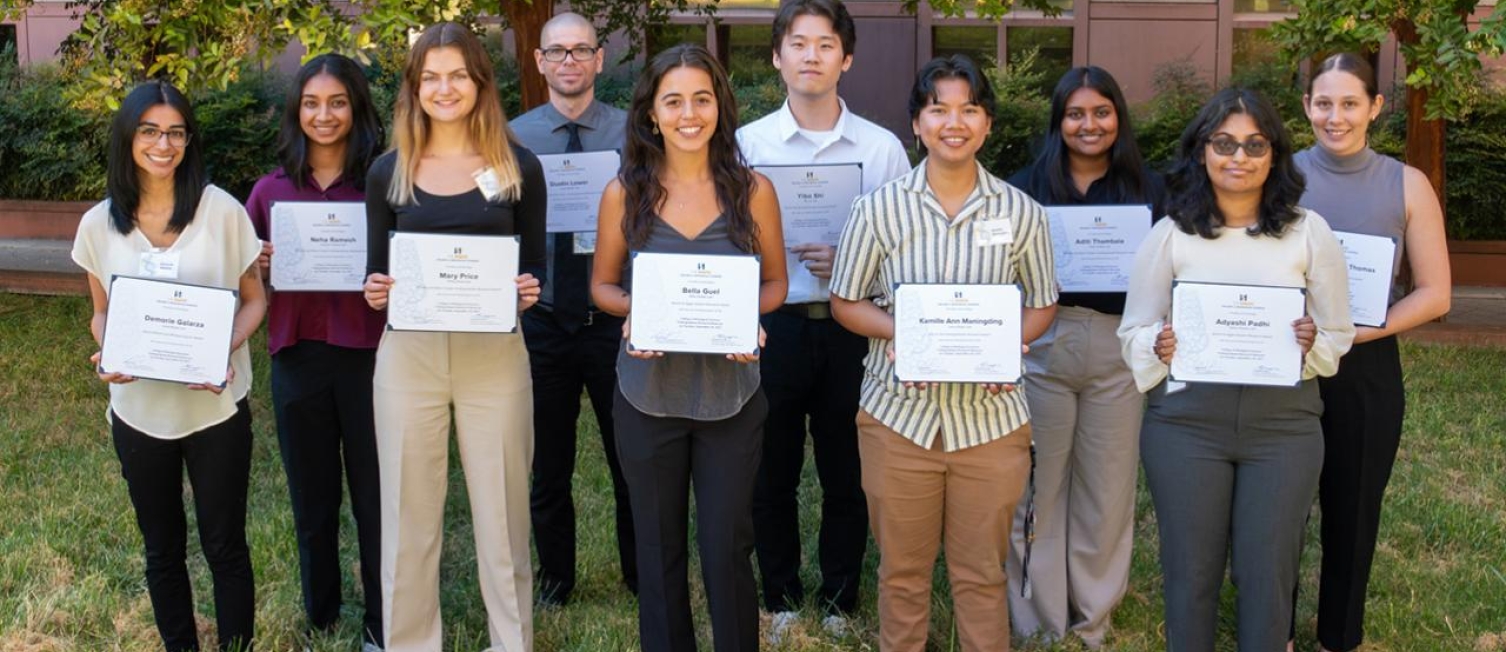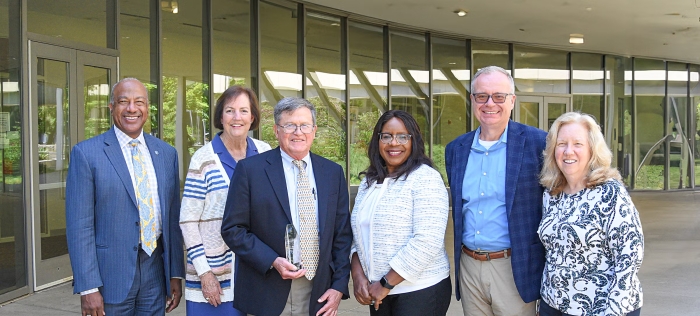
A summer of student research: donor-supported program fuels continuing exploration and hands-on learning
Many students who embark on research projects during the academic year face a roadblock during summer break when they leave campus to seek employment and have to shelve their scientific pursuits. To bridge this gap, the CBS Dean's Circle Summer Undergraduate Research Program (SURP) offers an invaluable opportunity.
The program provides undergraduates with mentorship, financial support and enables them to extend their research through a 10-week summer quarter. Generous contributions to the CBS Dean's Circle Fund make this annual initiative possible.
“Undergraduate lab work gives students first-hand experience of what a career in a science field will be like,” said Michael Lassner, an annual donor who helps support the college’s undergraduate research opportunities. “It also provides students with strong credentials that help them when they apply for jobs or for graduate school. I’m grateful for the chance to help put students on a superior career track.”
“Being a researcher is tough, and being one early in your career can be a real challenge,” says Gregg Recanzone, the associate dean of research and resources in CBS, who has been involved with the program since its first cohort in 2020. Though SURP went on hiatus in 2021 because of the pandemic, its return has been met with enthusiasm from the students. Says Recanzone, “SURP allows the students learn in an environment that helps them see their aspirations as exciting and possible.”
The SURP 2023 student cohort presented their research to CBS faculty, peers and donors on Tuesday, September 26.
Meet the Cohort of SURP 2023 Students

Demorie Galarza
Major: Plant Sciences
Lab: Laura Bogar, Department of Plant Biology
Award: Stacey Roberts and Michael Lassner Award
Project summary: Ectomycorrhizal Symbiosis Improves Water Relations in Douglas-fir Drought
Californian landscapes face worsening droughts and heat stress due to climate change, impacting agriculture and forest survival. My project focuses on how ectomycorrhizal fungi influence plant responses to these stresses, particularly in Douglas fir seedlings. It examines gene expression changes in plants and fungi during drought and heat stress and explores the benefits of multiple fungal associations. The broader goal is to understand the role of symbiotic fungi in plant stress tolerance and develop strategies for climate change mitigation in all plant communities.

Bella Guel
Major: Biological Sciences
Lab: Gitta Coaker, Department of Plant Pathology
Award: Alumni to Aggie Student Research Award
Project summary: Investigating Candidatus Liberibacter solanacearum effectors responsible for morphological changes in tomato
Vector-borne pathogens are responsible for causing devastating plant diseases, and their prevalence is predicted to increase due to climate change. Candidatus Liberibacter solanacearum (Lso) is a phloem-limited pathogen associated with multiple economically important diseases in solanaceous crops. My research aims to examine if Lso secreted effectors are responsible for altering host morphology and physiology which may facilitate disease establishment. From working on this project I have learned several microbiology techniques, developed expression systems, and increased my overall knowledge of vector-borne disease biology.

Dustin Lower
Major: Plant Biology
Lab: Laura Bogar, Department of Plant Biology
Award: Maud Wrightson Hinchee, Ph.D. Undergraduate Research Award
Project summary: The Impact of Wildfires on a Seedling's Ability to Establish Mycorrhizal Associations
Understanding the ecological impact of wildfires is crucial. Most trees depend on mycorrhizal fungi for water and nutrient uptake, but the full extent to which wildfires disrupt this symbiotic relationship remains unclear. To study this, I collected soil samples from areas that experienced varying degrees of burn severity and used the soils to conduct a bioassay with conifer seedlings. To better mimic existing forest ecology in California, drought stress will also be included. I will measure seedling success through germination rate, biomass, nutrient levels, and the extent of mycorrhizal colonization, while also examining overall fungal community composition between the respective treatment groups. The research I am conducting, and plan to expand on in the future, will hopefully help us understand the effects of burn severity and symbiotic interactions on forest recovery in fire-impacted California.

Kamille Ann Maningding
Major: Molecular and Medical Microbiology
Lab: Celina Juliano, Department of Molecular and Cellular Biology
Award: Roy H. Doi Undergraduate Research Award
Project summary: Investigating Metalloprotease Expression in Hydra Head Regeneration
Hydra vulgaris, a regenerative cnidarian and one of the simplest multicellular organisms, shares conserved proteins in its extracellular matrix (ECM) with other animals, yet its ECM's role in regeneration remains unclear. I wanted to investigate if these regenerative properties could be applied similarly to “immortal” HeLa cells and to grasp the process of cell regeneration. As part of my research, I developed in situ hybridization probes to aid in pinpointing protein expression during head regeneration, advancing our comprehension of injury recovery in hydra animals. My project helped deepen my understanding of metalloproteases crucial for Hydra head regeneration, impart foundational research skills, and enhance my microscopy expertise.

Adyasha Padhi
Major: Biochemistry and Molecular Biology
Lab: Aldrin Gomes, Department of Neurobiology, Physiology and Behavior
Award: Alumni to Aggie Student Research Award
Project summary: Determine if NSAID Diclofenac Increases Oxidative Stress and Causes Damage to Heart Cells
Taking non-aspirin nonsteroidal anti-inflammatory drugs (NSAIDs), like diclofenac, can increase stroke risk. My hypothesis suggests diclofenac may induce oxidative stress, causing heart issues. To test this, I performed rat cardiac cell experiments measuring oxidative stress and cell damage. I plan to continue researching the effects of diclofenac on cardiac function long-term, and aspire to a career in translational research, making this research on widely-used NSAIDs particularly appealing as it affects millions. This summer experience has helped solidify my interest in pursuing a Ph.D. or M.D.-Ph.D.

Mary Price
Major: Biological Sciences
Lab: Phillip Zerbe, Department of Plant Biology
Award: Charles and Nanci Cooper Undergraduate Research Award
Project summary: Examine Switchgrass Response to Drought Conditions to Understand the Function of Root-Based Metabolites
Switchgrass (Panicum virgatum), a robust North American plant, exhibits exceptional environmental resilience and drought tolerance, making it a promising candidate for biofuel production. Under drought stress, switchgrass responds by producing terpenoids, specialized metabolites that are vital for defense in related plant species. This project aims to investigate the biosynthesis and function of panicoloids, the downstream products of terpenoid synthesis. It is my expectation that the study's outcomes will inform biofuel crop optimization strategies.

Neha Ramesh
Major: Cell Biology
Lab: Chang-il Hwang, Department of Microbiology and Molecular Genetics
Award: Charles and Nanci Cooper Undergraduate Research Award
Project summary: Investigating the Role of PDZRN3 Knockdown on Pancreatic Cancer Metastasis
Pancreatic Ductal Adenocarcinoma (PDAC) is a major cause of cancer-related deaths and has a low five-year survival rate. PDZRN3, a gene associated with poor survival in PDAC patients, may play a role in PDAC metastasis, but the mechanism remains unclear. PDZRN3 regulates a molecular signaling pathway implicated in cell migration via epithelial-mesenchymal transition (EMT). EMT transforms cells, promoting migration through cytoskeletal changes and loss of cell adhesion. The project aims to understand how PDZRN3 loss promotes EMT in PDAC cells, potentially aiding metastasis. The long-term goal is to use PDZRN3 as a prognostic marker and target for PDAC therapy.

Camila Sanudo Thomas
Lab: Javier Arsuaga, Department of Molecular and Cellular Biology
Award: Alumni to Aggie Student Research Award
Project summary: Classifying P4 Bacteriophage Knotted DNA using Topological Analysis
Double-stranded DNA is densely packed within icosahedral bacteriophages in organisms, forming a liquid crystalline state under intense pressure. While experimental evidence supports this, a precise mathematical model is lacking. Research has revealed DNA spools near the capsid surface but disorder toward the center. Knot formation in DNA may result from this liquid crystalline structure. To investigate this, a hybrid plasma will be analyzed to determine if shorter DNA can also be modeled using liquid crystal concepts. My project aims to gather the experimental data needed to improve our mathematical model.

Yibo Shi
Major: Cell Biology
Lab: Bo Liu, Department of Plant Biology
Award: Khaira Family Experiential Learning Award
Project description: Dynamics of the MKK6 Kinase During Cytokinesis in Arabidopsis
Plant cell development, or cytokinesis, involves the phragmoplast composed of microtubules, which form the cell plate. A MAP Kinase cascade (ANP, MKK6, MPK4) regulates this process. NACK1, a kinesin-like protein, was believed to activate the cascade, but recent findings have challenged this. To investigate this we examined this cascade in plants and found that indeed confirmed that MKK6 and MPK4 were functional and involved in midzone localization in dividing tobacco cells. This research aims to determine whether the MAP Kinase cascade proteins localize independently of NACK1 and understand their dynamics. This work reflects my growing interest in plant cell biology, fostering my research skills and preparing me for a future in science.

Aditi Thambala
Major: Genetics and Genomics
Lab: Sean Collins, Department of Microbiology and Molecular Genetics
Award: Charles and Nanci Cooper Undergraduate Research Award
Project description: Establishing LovHK Two-Component System within Mammalian Cells for Immunotherapy
Cell-based immunotherapy holds great promise for improving human health, but it poses risks and is currently limited in application. Cell engineering can mitigate these issues by manipulating cellular interactions, but approaches can lead to unintended interactions. To address these concerns, we propose using two-component systems (TCS) involving a histidine kinase (HK) sensor and a response regulator (RR). TCS can be activated and deactivated by the same sensor, potentially minimizing unintended or negative effects. This project aligns with my long-term goals of contributing to genetic engineering and gene therapy research in the pharmaceutical or biotechnology industry.


